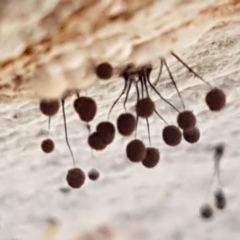Sighting 4377469
Throsby, ACT
Identification history
| Stemonitales (Order) | 30 Mar 2021 | Heino1 | ||
| Stemonitales (Order) | 30 Mar 2021 | trevorpreston |
Identify this sighting
Please Login or Register to identify this sighting.
10 comments
trevorpreston
wrote:
31 Mar 2021
There are two groups here but they were only about 70mm apart on the same log.
Teresa
wrote:
31 Mar 2021
Fair chance they are the same species however, the darker one shows the hypothalus very clearly, not so clear on the first one giving it the appearance of a different species. Very difficult to know without doing the microscopy. Were you able to collect a sample for Heino to put under the scope?
trevorpreston
wrote:
31 Mar 2021
No sample taken. Didn't even know getting a slime mould under the microscope was a possibility.
Is this something heino1 is keen to do?
Is this something heino1 is keen to do?
trevorpreston
wrote:
31 Mar 2021
No worries, next time I find something interesting I will try and remember to get a sample.
Two questions though, 1. can you give me any indication of what things to take a sample of and 2. how do I keep a sample of a slime mould? I assume I would need to get it to you fairly quickly before it deteriorates?
Two questions though, 1. can you give me any indication of what things to take a sample of and 2. how do I keep a sample of a slime mould? I assume I would need to get it to you fairly quickly before it deteriorates?
Teresa
wrote:
31 Mar 2021
When collecting myxos, try to cut a little of the substrate beneath the myxo then carefully place the substrate and specimen into a small air tight container to carry it home, being very careful not to shake or disturb it too much. These are very delicate and break fairly easily. When at home, open the container and leave the specimen to air dry in a warm safe spot where it won't be disturbed by breeze, people or pets. After about two weeks, the substrate can be glued onto a piece of cardboard, that way the specimen will remain attached and firmly safe. Then place it in something like a matchbox and drop it into the herbarium for ID with all details of date, place of collection, type of substrate, your details etc. These creatures can be keep for many years and still remain viable, but best stored in a safe place like the herbarium, given the changeable climate of the Canberra region. If Heino is not wanting it then we can arrange in email to exchange postal address.
Heino1
wrote:
31 Mar 2021
A warning. Depending on where you collect in the ACT you may need a collecting permit to collect legally. Definitely so in nature reserves. I certainly don't want to dampen your enthusiasm in the slightest (and Canberra Nature Map sightings have already led to very useful herbarium collections) but it pays to know the legalities. If you'd like to know more about how to collect, I'm happy to talk to you about this.
Teresa
wrote:
31 Mar 2021
The new book by Steve Stephenson - Secretive Slime Moulds Myxomycetes of Australia - is now available. Easy to read and very informative; produced by CSIRO - Enjoy
Please Login or Register to comment.
Nearby sightings
Location information
- Coordinates 149.174229-35.205340
- Maps Goorooyarroo NR (ACT)
- Places Throsby, ACT
Sighting information
- 5 Abundance
- 30 Mar 2021 11:02 AM Recorded on
- trevorpreston Recorded by
Species information
- Stemonitales (Order) Scientific name
- Common name
- Not Sensitive
- Local native
- Non-Invasive
- Up to 811.61m Recorded at altitude
- Machine learning
Record quality
- Images or audio
- More than one media file
- Verified by an expert moderator
- Nearby sighting(s) of same species
- GPS evidence of location
- Description
- Additional attributes
































